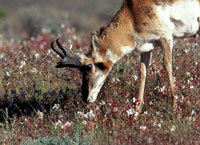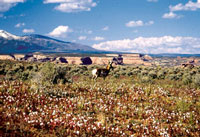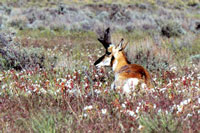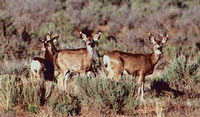
They have their own song, “Where the deer and the antelope play,” but those words first written in 1876 were a bit misleading. “Where the deer and the pronghorn play,” doesn’t have the same ring, but is biologically more correct.
The American pronghorn, swiftest North American land mammal, is the lone member of the Antilocarpidae family of even-toed hoofed mammals. Placed in the genus Antilocarpa, which means “antelope-goat,” these desert dwellers are distinct from their African relatives.
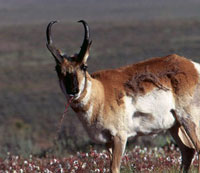
Prior to westward settlement, an estimated 30-60 million pronghorn roamed across the vast interior of North America. Hunting and habitat conversion reduced that number to around 20,000 by the early 1920s. In addition, barbed wire may have tamed the West, but it was detrimental to the non-fence jumping pronghorn.
Unlike deer and elk which shed antlers, pronghorn horns are a bony core surrounded by a sheath of specialized skin and fused hairs. These sheaths are shed annually in early winter and replaced by mid-summer. On the bucks these horns may reach 10-20 inches long and have a small notch or prong, which gives them their common name, that points forward. The rest of the black horn curves backwards and slightly inwards. Females also have horns, but these are much smaller.
Creatures of the American savannah – open grasslands and shrublands – the pronghorn relies on keen eyesight and speed to elude predators. Their large eyes are set in bony rings that provide them a great field of vision. When threatened, a pronghorn erects the white hairs on its rump effectively doubling this patch in size. This white flag does not indicate surrender, but is a visual alarm sign to other pronghorn. And for those other pronghorn not paying attention, the sentry may release an odor from their rump glands that gets the herd’s attention.
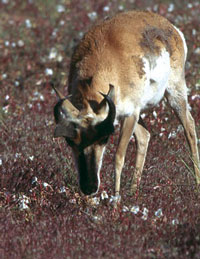 Starting in late summer and early fall, male pronghorns defend breeding territories and gather harems. Polygynous by nature, male pronghorns may breed with up to 20 does. Chasing, jousting and other displays between males occur during this time. Males may also be observed “battling” bushes, but this behavior places scent marks on vegetation to help define these boundaries.
Starting in late summer and early fall, male pronghorns defend breeding territories and gather harems. Polygynous by nature, male pronghorns may breed with up to 20 does. Chasing, jousting and other displays between males occur during this time. Males may also be observed “battling” bushes, but this behavior places scent marks on vegetation to help define these boundaries.
With a one-month delayed period between breeding and implanting of the eggs in the uterus, the does have a seven to eight month gestation period. Fawns born in spring can outrun a coyote within a few weeks.
The Cisco Desert along Interstate 70, the west side of State Highway 191 from the Interstate south towards the Canyonlands Airport, and the Hatch Point area down by the Wind Whistle Campground have extensive areas of grasslands and shrublands that support pronghorn. Use your vehicle like a viewing blind rather than stepping out of the vehicle for a closer look at these magnificent animals. Besides coyotes and bobcats preying on young pronghorns, the next major predator is humans, and a pronghorn will quickly put distance between themselves and a hiker. And though pronghorn are active throughout the day, even in the August heat, early morning and evening are the best hours to search for pronghorns “at play.”



 Starting in late summer and early fall, male pronghorns defend breeding territories and gather harems. Polygynous by nature, male pronghorns may breed with up to 20 does. Chasing, jousting and other displays between males occur during this time. Males may also be observed “battling” bushes, but this behavior places scent marks on vegetation to help define these boundaries.
Starting in late summer and early fall, male pronghorns defend breeding territories and gather harems. Polygynous by nature, male pronghorns may breed with up to 20 does. Chasing, jousting and other displays between males occur during this time. Males may also be observed “battling” bushes, but this behavior places scent marks on vegetation to help define these boundaries.